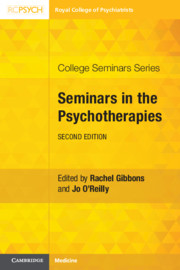Book contents
- Seminars in the Psychotherapies
- College Seminars Series
- Seminars in the Psychotherapies
- Copyright page
- Reviews
- Contents
- Contributors
- Foreword
- Preface
- Part I Therapy Theory and Practice
- Section 1 Psychodynamic Psychotherapy
- Section 2 Other Forms of Psychotherapy
- Chapter 7 Cognitive Behavioural Therapy and Dialectical Behavioural Therapy: An Introduction
- Chapter 8 Brief Psychodynamic Psychotherapies
- Chapter 9 Systemic Family Therapy
- Chapter 10 Cognitive Analytic Therapy (CAT):
- Chapter 11 Group Analytic Psychotherapy and the Group Analytic Model: A Clinician’s Guide
- Chapter 12 Mentalizing in Psychiatric Practice
- Part II Applied Psychotherapeutic Thinking
- Index
- References
Chapter 9 - Systemic Family Therapy
from Section 2 - Other Forms of Psychotherapy
Published online by Cambridge University Press: 27 May 2021
- Seminars in the Psychotherapies
- College Seminars Series
- Seminars in the Psychotherapies
- Copyright page
- Reviews
- Contents
- Contributors
- Foreword
- Preface
- Part I Therapy Theory and Practice
- Section 1 Psychodynamic Psychotherapy
- Section 2 Other Forms of Psychotherapy
- Chapter 7 Cognitive Behavioural Therapy and Dialectical Behavioural Therapy: An Introduction
- Chapter 8 Brief Psychodynamic Psychotherapies
- Chapter 9 Systemic Family Therapy
- Chapter 10 Cognitive Analytic Therapy (CAT):
- Chapter 11 Group Analytic Psychotherapy and the Group Analytic Model: A Clinician’s Guide
- Chapter 12 Mentalizing in Psychiatric Practice
- Part II Applied Psychotherapeutic Thinking
- Index
- References
Summary
Family therapy represents a major conceptual shift in the approach to understanding and treatment of psychological disturbance and mental illness. Within this approach symptoms are understood as the consequence of disturbance in the functioning of the family as a whole, expressed by the individual with the manifest difficulty. An understanding of how the identified patient and family affect each other both positively and negatively can lead to effective family interventions.
- Type
- Chapter
- Information
- Seminars in the Psychotherapies , pp. 111 - 124Publisher: Cambridge University PressPrint publication year: 2021



